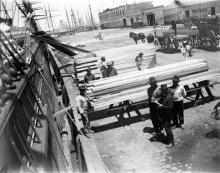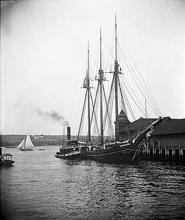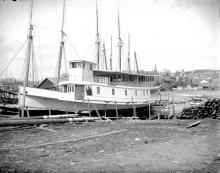Shipping
Sailing vessels were basic to Penobscot Bay’s development in the nineteenth century. Often more than 10,000 sailing vessels left and came back to the Bay annually.
Shipping by water was and still is the cheapest means to carry large cargoes long distances. Penobscot Bay’s products primarily were shipped to eastern U.S. cities, West Indian islands, and South America. Fewer Bay products went to Europe and other destinations.
Shipping companies and merchants continually seek ways for smaller crews to move more cargo. In the days of sail, the schoonerSchooner
A sailing vessel of two or more masts, all fore-and-aft rigged. The Thomas W. Lawson, built in 1902, had seven masts. In comparison to a square-rigged vessel of comparable tonnage, a schooner is better for coastwise sailing. was the most efficient for the East Coast and West Indies trades. By 1900, schooners had become very large— some were over 300 feet in length with up to six masts. The first six-master was the George W. Wells, built in Camden in 1900. Two- and three- masted schooners were more common, and functioned as the “tractor-trailers” of their day.
SteamboatSteamer steamboat,steamship
A mechanically-propelled vessel in which the principal motive power is steam, as opposed to a sailing vessel or motorship. Steamboats traditionally were the sometimes sizable coastal steamers, while steamship referred to ocean going vessels. service started modestly before the Civil War, and expanded greatly after it. Smaller and more valuable cargoes typically were shipped to and from Maine by steamboat. The daily boat from Bangor to Boston, via Winterport, Stockton Springs, Searsport, Belfast, Camden, and Rockland, carried passengers, perishable products, and manufactured goods needing expedient transport. In many ways, the regularly scheduled steamboats became Penobscot Bay’s lifeline.
Besides their export function, sailing vessels also brought cargoes to Penobscot Bay, including manufactured goods, molasses from the West Indies, grain, flour, hides from South America, and salt for the fishing industry and for other food preservation. Coal became the main cargo late in the nineteenth century and through the first half of the twentieth century. The large schooners of the late 19th century were built primarily as colliersCollier
Vessel designed specifically to carry coal. Some were designed so that coal could be transferred to other ships directly. rather than for Penobscot cargoes. As steam power became more efficient, many schooners were turned into bargesBarge
The general name given to a flat-bottomed rigged or unrigged craft with a full body and heavy construction. Usually for transportation of bulky freight such as coal, lumber, sand, or stone., which were towed up and down the coast by large tugboats.
Railroads linked Penobscot Bay to inland towns. Many ship owners invested in railroads. In Belfast, in 1867 the Belfast and Moosehead Lake Railroad was built to bring in cargoes. The Knox and Lincoln Railroad, started in 1871, linked Bath and Rockland, transporting goods from smaller towns. In 1905, the Bangor and Aroostook RailroadBangor and Aroostook Railroad
This rail line was formed in 1891 to combine the lines of the Bangor and Piscataquis Railroad and the Bangor and Katahdin Railroad.
Read More came to Searsport, creating what is now Maine’s second largest port. Eventually, increased efficiency of the railroads, along with improved roads and trucks, helped put both sailing and steam vessels out of business.



